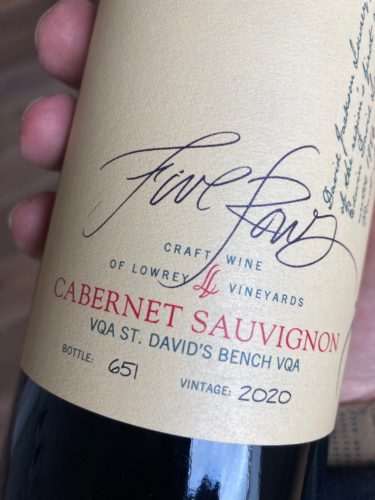
2021 Syrah
The nadir of the 2021 vintage on our farm was surely encountered in the days leading up to the Syrah harvest.
Soaking rain, followed by consecutive days of dense fog and stagnant air combined to put our nearly-ripe Syrah on the precipice of breakdown. I remember taking pictures of the pea soup fog and the mushrooms sprouting out of the vine trunks, just to have record of how dire the situation was. Beset by an unsettling feeling, I began to notice that the skins on a few, then many berries were starting to lose their integrity and become discoloured and mouldy. It was evident that some kind of fungal pathogen, likely Botrytis, was taking over and there was little time to act.
I’d seen this many times before, but not with such rapidity. The only course of action was to get the grapes off as soon as possible and deal with the soggy consequences in the winery.
The vigilance in fruit selection we employed that foggy October day bordered on silliness, with all clusters having to be methodically pored over to remove the worst-affected berries. The Syrah clusters were abnormally tight in 2021, which only added to their susceptibility. We ended up with less than one tonne of fruit when all was said and done, our lowest yield to date, but to have any fruit to vinify in this freak scenario was a victory in itself.
My first concern as a winemaker when working with “soft” skins is the unknown extent of the botrytis. Unlike white grapes that are pressed off the skins before fermentation, red grapes are fermented with skins and even given some extended maceration time afterwards if so desired. Having a high percentage of compromised skins in the must can lead to many issues with fermentation dynamics and eventually fining or filtration. So, with that in mind, the remedial protocol I employed was to forgo a cold soak, expediate the fermentation process and lightly press at dryness to limit overall contact with the skins.
The finished wine was pleasantly smooth from the get-go, likely due to a combination of limited skin contact and the clarification enzymes I added to remove unwanted botrytis metabolites. I think the saving grace for this wine (but the kiss of death for the greater crop) was just how ripe the fruit was when the rains came and the fog eventually rolled in. All components, including tannins, acid, pH and sugars were at or near optimal levels by the time we rushed in to hand pick.
It’s crazy to say, but at the moment this might be my favourite of the 2021 reds. It features invitingly smooth tannins, but doesn’t lack structure or length. I love the cool climate Syrah staple of pepperiness and blackberry, and the savoury components present on the palate. Total production was 42 cases, two of which will be set aside for my own personal collection.
Just another unique entry into the ever-widening Syrah vintage variation spectrum. After all, variety is the spice of life!


